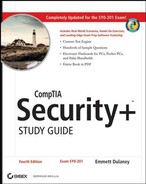T
- tap
A type of connection that directly attaches to a cable.
- TCP
See Transmission Control Protocol (TCP).
- TCP ACK attack
An attack that begins as a normal TCP connection and whose purpose is to deny service. It's also known as a TCP SYN flood.
- TCP sequence attack
An attack wherein the attacker intercepts and then responds with a sequence number similar to the one used in the original session. The attack can either disrupt a session or hijack a valid session.
- TCP SYN flood
See TCP ACK attack.
- TCP wrapper
A low-level logging package designed for Unix systems.
- TCP/IP
See Transmission Control Protocol/Internet Protocol (TCP/IP).
- TCP/IP hijacking
An attack in which the attacker commandeers a TCP session from a legitimate user after the legitimate user has achieved authentication, thereby removing the need for the attacker to authenticate himself.
- teardrop attack
A DoS attack that uses large packets and odd offset values to confuse the receiver and help facilitate a crash.
- Telnet
A protocol that functions at the Application layer of the OSI model, providing terminal emulation capabilities. See also Open Systems Interconnection (OSI) model.
- Temporal Key Interchange/Integrity Protocol (TKIP)
A wrapper that works with wireless encryption to strengthen WEP implementations.
- Terminal Access Controller Access Control System (TACACS)
An authentication system that allows credentials to be accepted from multiple methods, including Kerberos. The TACACS client/server process occurs in the same manner as the Remote Authentication Dial-In User Service (RADIUS) process.
- terminal emulator
A program that enables a PC to act as a terminal for a mainframe or a Unix system.
- termination policy
A clear process of informing affected departments of a voluntary or involuntary termination.
- test account
An administrator-created account for confirming the basic functionality of a newly installed application, for example. The test account has equal rights to accounts that will use the new functionality. It's important to use test accounts instead of administrator accounts to test new functionality. If an administrator account is used, problems related to user rights might not manifest themselves because administrator accounts typically have full rights to all network resources.
- TFTP
See Trivial File Transfer Protocol (TFTP).
- thin client
Systems that don't provide any disk storage or removable media on their workstations.
- third party
A party responsible for providing assurance to the relying party that a subscriber is genuine.
- threat
Any perceivable risk.
- three-tier model
A system that effectively isolates the end user from the database by introducing a middle-tier server.
- time to live (TTL)
A field in an IP packet that indicates how many routers the packet can cross (hops it can make) and how long it takes before it's discarded. TTL is also used in Address Resolution Protocol (ARP) tables to indicate how long an entry should remain in the table.
- TLS
See Transport Layer Security (TLS).
- token
A piece of data holding information about the user. This information can contain group IDs, user IDs, privilege level, and so on.
- Traceroute
See Tracert.
- Tracert
The command-line utility that shows the user every router interface a packet passes through on its way to a destination.
- trailer
A section of a data packet that contains error-checking information.
- transceiver
A device that allows the network interface card (NIC) to connect to the network.
- transmission
Sending packets from the PC to the server. The transmission can occur over a network cable, wireless connection, or other medium.
- Transmission Control Protocol (TCP)
The protocol found at the Host-to-Host layer of the Department of Defense (DoD) model. This protocol breaks data packets into segments, numbers them, and sends them in order. The receiving computer reassembles the data so that the information is readable for the user. In the process, the sender and the receiver confirm that all data has been received; if not, it's resent. TCP is a connection-oriented protocol. See also connection-oriented.
- Transmission Control Protocol/Internet Protocol (TCP/IP)
The protocol suite developed by the Department of Defense (DoD) in conjunction with the Internet. It was designed as an internetworking protocol suite that could route information around network failures. Today it's the de facto standard for communications on the Internet.
- transmission media
Physical cables and/or wireless technology across which computers are able to communicate.
- Transport layer
The fourth layer of the OSI model. It's responsible for checking that the data packet created in the Session layer was received. If necessary, it also changes the length of messages for transport up or down the remaining layers. See also Open Systems Interconnection (OSI) model.
- Transport Layer Security (TLS)
A protocol whose purpose is to verify that secure communications between a server and a client remain secure. Defined in RFC 2246.
- Triple-DES (3DES)
A symmetric block cipher algorithm used for encryption.
- Trivial File Transfer Protocol (TFTP)
A UDP-based protocol similar to FTP that doesn't provide the security or error-checking features of FTP. See also File Transfer Protocol (FTP).
- Trojan horse
Any application that masquerades as one thing in order to get past scrutiny and then does something malicious. One of the major differences between Trojan horses and viruses is that Trojan horses tend not to replicate themselves.
- Trust List
A list of objects signed by a trusted entity. Also known as a Certificate Trust List (CTL).
- Trusted Platform Module (TPM)
A method of utilizing encryption and storing the passwords on a chip. The hardware holding the chip is then needed to unencrypt the data and make it readable.
- TTL
See time to live (TTL).
- tunneling
The act of sending data across a public network by encapsulating it into other packets.
- two-factor authentication
Using two access methods as a part of the authentication process.
- two-tier model
A model in which the client PC or system runs an application that communicates with a database that is running on a different server.
